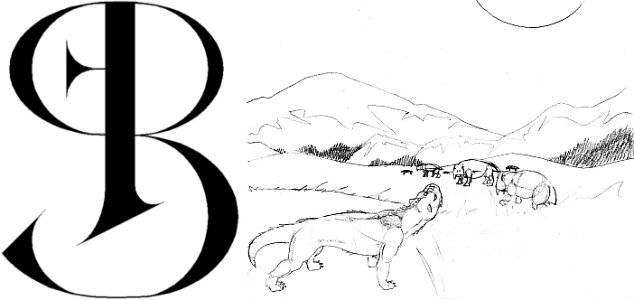Dromaeosaurs are those sickle clawed "raptor" dinosaurs which have become contenders for scariest dinosaurs in popular imagination (in spite of their modest size) thanks to Jurassic Park.
If you know your dromaeosaurs, you probably thought those "velociraptors" in Jurassic Park were a tad on the big side. That's because they are actually supposed to be Deinonychus, a man-sized dromeosaur species which Greg Paul had classified as a subspecies of Velociraptor for a while. You can see this in Paul's excellent dinosaur art/science book Predatory Dinosaurs of the World (hardcover and paperback versions available at Amazon.com.) Since writing that book, Greg Paul has concluded that Deinonychus is actually a separate species after all. (The Jurassic Park Deinonychus are still much bigger than they should be, but the dromaeosaur Utahraptor actually was that big.)
Jurassic Park's "raptors" inherited another mistake which was common for dinosaur artists and scientists at the time: the wrists are broken. The palms of predatory dinosaur hands face inward, not backward, with the "thumbs" pointing forward - like the wrists of a bird or like our hands when we climb a rope, but not when we climb a ladder. I was at the "Collossal Fossils" exhibit at the Pacific Science Center recently and all of the predatory dinosaurs had their wrists the wrong way. When you look at the bones up close you can see how this just doesn't work.
When I saw Jurassic Park for the first time, I was a bit disappointed that they didn't have any feathered dinosaurs. They used the Greg Paul's new classification scheme, and his ridiculously fast Tyrannosaurus, but left out his feathered dromaeosaurs! Paul illustrated all of his small dinosaurs with downy "protofeathers" and gave the dromaeosaurs wing feathers. We don't know if all of the small dinosaurs had feathers, but last month Alan Turner, Peter Makovicky and Mark Norell described direct physical evidence for flight feathers on the forearms of Velociraptor.
Dromaeosaurs are so closely related to birds, that they might actually be secondarily flightless descendants of the first flying dinosaurs. I recently read Greg Paul's new book on this subject: Dinosaurs of the Air. The new book is more science and less art-oriented than Predatory Dinosaurs of the World. Paul looks at dinosaur metabolism in terms of aerobic excercise (instead of "warm blooded or cold blooded") which allows us to draw conclusions from the bones themselves, and even identify which dinosaurs probably had "in-between" metabolisms.
Saturday, October 27, 2007
Thursday, October 25, 2007
Hobgoblin vs. The 'Roid
In the Squawk RPG, a hobgoblin is an intelligent dromaeosaur. The basic body plan is like other dromaeosaurs, but the flexibility of the hand and arms is increased and a much larger brain gives the skull a bulbous, rounded shape.

The hobgoblin's "conservative" shape - very similar to the real-life dromaeosaurs - is in part a reaction to Dale Russel's dinosauroid. Dromaeosaurs are already big-headed bipeds with grasping hands, so the dinosauroid's human-like body shape is mostly superfluous. See my gremlin post for more information.

- (top left) street-fighter with feet and hands wrapped
- (top right) armored with saber and wing-shaped sheild
- (middle) soldier with helmet and revolver bayonets
- (bottom left) bioarmor with rockets and arm cannons
- (bottom right) wizard? on fire!?
The hobgoblin's "conservative" shape - very similar to the real-life dromaeosaurs - is in part a reaction to Dale Russel's dinosauroid. Dromaeosaurs are already big-headed bipeds with grasping hands, so the dinosauroid's human-like body shape is mostly superfluous. See my gremlin post for more information.
Subscribe to:
Posts (Atom)
